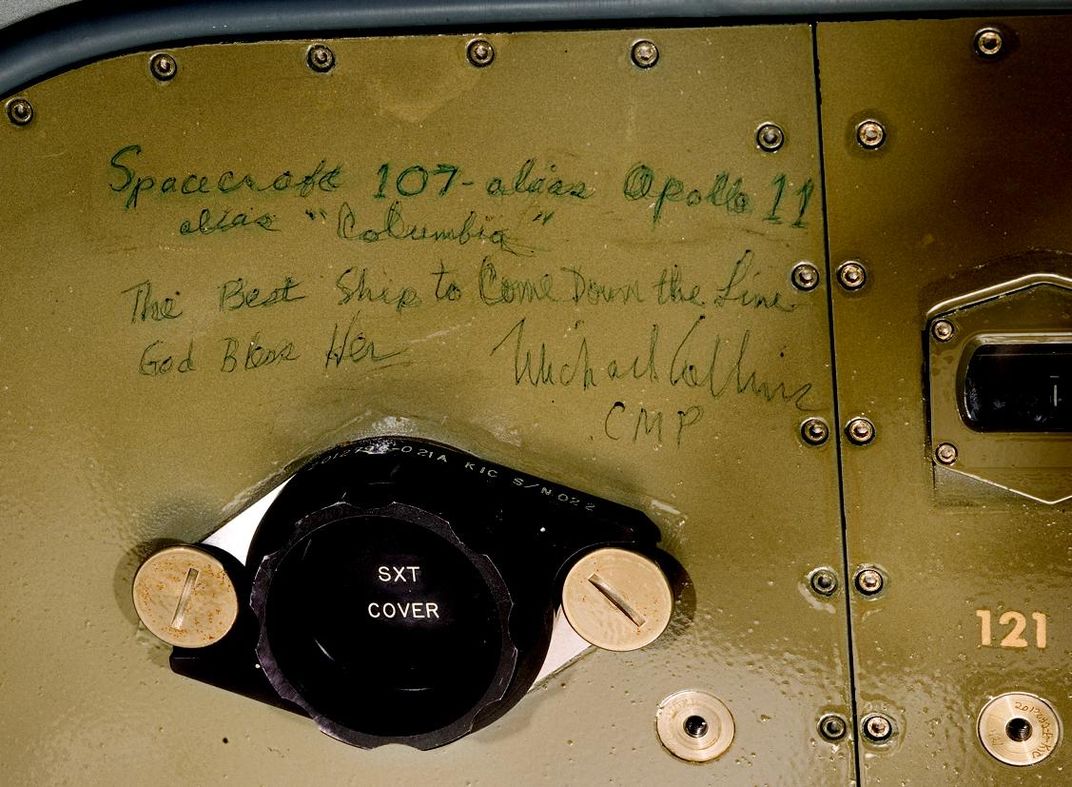Apollo 11 Command Module Makes Another Journey
The command module “Columbia” will visit four U.S. museums, leaving DC for the first time in 46 years.
/https://tf-cmsv2-smithsonianmag-media.s3.amazonaws.com/filer/ee/59/ee5943e2-a17d-4f68-865f-83665f8e49bc/nasm201601617web.jpg)
After spending 46 years parked at the Smithsonian's National Air and Space Museum, the Apollo 11 command module Columbia will travel again. This time, the journey will not be quite as epic as to the moon and back, but the trip is still historic. The spacecraft will visit the cities of Seattle, Houston, St. Louis and Pittsburgh for a new traveling exhibition, "Destination Moon: The Apollo 11 Mission."
Columbia, which the museum has designated a "milestone of flight," transported Edwin "Buzz" Aldrin, Neil Armstrong and Michael Collins to an orbit around the moon in 1969. Aldrin and Armstrong used a detachable landing craft, the lunar module Eagle, to descend to the surface, where on July 20, 1969, Armstrong took mankind's first steps on the moon. Columbia transported the trio back to Earth, where the spacecraft splashed down in the Pacific ocean four days later.
After the command module was hoisted on to the deck of an aircraft carrier and taken home to the United States, it made a nationwide tour that ended in 1971 when Columbia arrived at the Smithsonian Institution in Washington D.C. Now it will travel to four different museums over the course of two years before the 50 year anniversary of the lunar landing.
Last year, museum staff entered Columbia for the first time in decades. A detailed 3D scan was made of the entire interior in order to become part of a digital component of the traveling exhibition, which will also include 20 of the more than 400 objects that were removed from Columbia.

Astronaut graffiti has been left intact.
“We were really excited to see the graffiti that was documented when the Digitization Program Office did their exterior and interior scans,” says Kathrin Halpern, project director for the Smithsonian Institution Traveling Exhibition Service, which is taking Columbia on the road. “The graffiti, some of it was known to exist. But since none of the curators had been able to enter the capsule it wasn't very well documented. The 3D scans brought those to light. . . Some of it is calculations making adjustments during the flight.”
While visitors cannot physically enter the spacecraft, those 3D scans will allow them to see everything.
“They'll be able to feel like they are moving around in the interior,” Halpern says. “They will be able to click on hot spots for more information.”
The four museums were selected based on a combination of geographic diversity, security and engineering.
“The Columbia and its transport ring are over 13,000 pounds,” Halpern says. “All of the venues had to submit engineering reports to show that floor load wasn't a problem. It's really a balancing act to make sure that we have as much of the country represented as possible but also the needs of the object and the security get considered.”
With security in mind, officials were unable to comment on the details of how and when Columbia will be transported. All we know is that it will be moved over land.
“I can tell you it will not be flown. Not again,” Halpern says. “It already took its flight. Certainly it's a lot shorter trip this time than the last.”
The Smithsonian Institution Traveling Exhibition Service will tour "Destination Moon: The Apollo 11 Mission" to the Space Center Houston in Texas (October 14, 2017 - March 18, 2018), the Saint Louis Science Center in Missouri (April 14, 2018 - September 3, 2018), the Senator John Heinz History Center in Pittsburgh, Pennsylvania (September 29, 2018 - February 18, 2019) and the Museum of Flight in Seattle, Washington (March 16, 2019 - September 2, 2019).
/https://tf-cmsv2-smithsonianmag-media.s3.amazonaws.com/accounts/headshot/JacksonLanders.jpg)
/https://tf-cmsv2-smithsonianmag-media.s3.amazonaws.com/accounts/headshot/JacksonLanders.jpg)